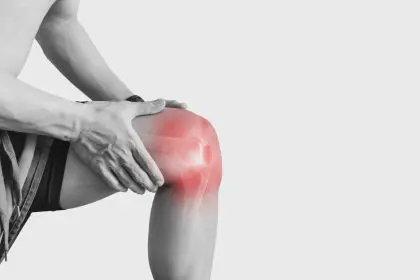Recent clinical research has unveiled groundbreaking developments in the application of GLP-1 medications for managing joint-related discomfort. These findings represent a significant shift in understanding how metabolic treatments might influence musculoskeletal health.
Weight Management Impact
The relationship between body mass and joint health reveals several key mechanisms through which maintaining a healthy weight can significantly improve joint function and overall well-being:
- Reduced Mechanical Stress on Weight-Bearing Joints
Excess weight puts additional stress on weight-bearing joints, such as the knees, hips, and spine. By reducing body mass, this mechanical load is alleviated, which can help prevent joint wear and tear and reduce the risk of conditions like osteoarthritis. - Decreased Inflammatory Markers in Tissue
Higher body fat can lead to increased production of pro-inflammatory cytokines, which contribute to joint inflammation. Reducing body weight helps decrease these inflammatory markers, improving joint health and alleviating pain associated with conditions like arthritis. - Improved Mobility and Physical Function
Weight management enhances mobility by reducing joint pain and stiffness, leading to better physical function. This can result in increased range of motion and the ability to perform daily activities more easily. - Enhanced Exercise Tolerance
Maintaining a healthy weight improves the ability to engage in physical activity without experiencing excessive discomfort or fatigue. This can contribute to long-term joint health by promoting movement and strengthening the muscles that support the joints. - Better Overall Joint Stability
Weight management can enhance joint stability by reducing excess pressure on the joints. Stronger muscles and ligaments, resulting from a balanced weight and regular exercise, contribute to better support for the joints, reducing the risk of injury.
Metabolic Mechanisms
GLP-1 medications influence joint health through several biological pathways that help improve both metabolic function and joint preservation:
- Regulation of Glucose Metabolism
GLP-1 medications help regulate blood sugar levels by promoting insulin release and inhibiting glucagon production. This regulation can prevent metabolic dysfunction, which has been linked to joint degeneration, particularly in individuals with conditions like diabetes. - Reduction of Systemic Inflammation
GLP-1 medications have been shown to reduce systemic inflammation, which plays a key role in the development of joint diseases such as arthritis. By lowering inflammation, these medications help protect joint tissue from damage and enhance overall joint health. - Improvement in Cellular Repair Processes
GLP-1 medications can accelerate cellular repair, including in joint tissues. This enhancement of the body’s natural healing processes helps repair damaged cartilage and other joint structures, supporting long-term joint integrity. - Enhancement of Cartilage Protection
By improving glucose metabolism and reducing inflammation, GLP-1 medications help protect cartilage, which is essential for smooth and pain-free joint movement. This protection can slow the progression of joint degeneration and reduce the need for surgical interventions. - Optimization of Metabolic Efficiency
GLP-1 medications also enhance metabolic efficiency, promoting fat loss while preserving lean muscle mass. This improvement in metabolism can reduce excess body weight, further benefiting joint health by decreasing the mechanical load and inflammation associated with obesity.
Clinical Outcomes
Research demonstrates significant improvements in several aspects of joint health and overall function when using GLP-1 medications as part of a comprehensive treatment plan:
- Daily Physical Function
Studies show that patients using GLP-1 medications experience improved daily physical function, such as the ability to perform basic activities of daily living (ADLs) without pain or difficulty, thanks to enhanced mobility and reduced inflammation. - Pain Reduction During Movement
One of the key benefits of weight management and metabolic regulation through GLP-1 medications is a reduction in joint pain, particularly during movement. This pain relief enhances the overall quality of life by making it easier to engage in physical activities. - Overall Mobility Scores
GLP-1 medications have been linked to higher mobility scores in clinical trials, indicating that patients experience greater freedom of movement and improved ability to perform activities that require flexibility and strength. - Quality of Life Metrics
Improvements in joint health, mobility, and pain reduction lead to a better overall quality of life. Patients often report feeling more energetic and able to engage in social and physical activities, which can enhance mental and emotional well-being. - Long-Term Joint Preservation
Long-term use of GLP-1 medications helps preserve joint health by preventing further cartilage degradation, reducing inflammation, and managing body weight. This preservation can delay or prevent the need for joint replacement surgery and improve long-term joint function.
Inflammatory Response
The medication’s effect on inflammation plays a central role in joint health:
- Decreased Inflammatory Markers
GLP-1 medications have been shown to reduce key inflammatory markers, which helps minimize joint swelling and pain associated with conditions like osteoarthritis and rheumatoid arthritis. - Reduced Joint Swelling
By controlling inflammation, GLP-1 medications reduce swelling in the joints, which is a common symptom in inflammatory joint diseases. Reduced swelling contributes to less pain and improved function. - Lower Levels of Oxidative Stress
Oxidative stress can lead to cellular damage and contribute to joint deterioration. GLP-1 medications help reduce oxidative stress, promoting healthier joint tissue and decreasing the risk of chronic joint diseases. - Improved Tissue Healing
The anti-inflammatory and antioxidant properties of GLP-1 medications support faster healing of damaged tissues. This includes the healing of cartilage and other connective tissues in the joints, leading to better overall joint function. - Enhanced Joint Lubrication
By reducing inflammation and oxidative stress, GLP-1 medications can improve the lubrication of joints. This can help reduce friction, improve joint movement, and alleviate pain associated with stiff or inflamed joints.
Physical Activity Benefits
Treatment with GLP-1 medications enables increased physical activity through several important benefits:
- Greater Exercise Capacity
With weight reduction and decreased pain, patients are better able to engage in physical activity, leading to enhanced exercise capacity. This not only benefits joint health but also supports cardiovascular and overall physical health. - Extended Duration of Movement
GLP-1 medications can help individuals tolerate longer periods of movement or exercise, promoting joint health and enhancing muscle strength, which provides better support for the joints over time. - Improved Balance and Coordination
As patients experience less pain and greater mobility, they often see improvements in balance and coordination. This can help prevent falls and reduce the risk of injury, particularly in older adults. - Enhanced Muscle Strength
Weight management and reduced pain allow individuals to engage in strengthening exercises, which build muscle around the joints and provide greater stability and protection against injury. - Better Joint Flexibility
Improved mobility, pain reduction, and muscle strengthening contribute to enhanced joint flexibility. This is crucial for maintaining a wide range of motion and preventing stiffness that can impact daily life.
Lifestyle Modifications
Success rates for joint health improvement increase when combined with other lifestyle modifications:
- Dietary Adjustments
A balanced, nutrient-rich diet supports weight loss and metabolic health. Reducing processed foods and increasing intake of anti-inflammatory foods can further enhance the effects of GLP-1 medications on joint health. - Regular Exercise Routines
Consistent physical activity, including both aerobic and strength training exercises, can improve joint flexibility, strengthen muscles, and contribute to overall joint stability, further supporting the effects of GLP-1 medications. - Proper Sleep Habits
Adequate sleep is essential for tissue repair and recovery. By improving sleep quality, individuals can support their body’s ability to heal and regenerate joint tissue, enhancing the effects of medication. - Stress Management
Chronic stress contributes to inflammation and worsens joint health. Implementing stress-reduction techniques such as meditation, yoga, or deep-breathing exercises can complement the benefits of GLP-1 medications. - Physical Therapy Participation
Working with a physical therapist can help individuals regain mobility and strength. Physical therapy, in combination with medication and lifestyle changes, can significantly improve joint function.
Long-Term Implications
Extended benefits of GLP-1 medications for joint health include:
- Reduced Need for Joint Replacement
By preserving joint function and reducing inflammation, GLP-1 medications may help individuals avoid the need for costly and invasive joint replacement surgeries. - Lower Risk of Falls
Improved balance, muscle strength, and mobility reduce the risk of falls, particularly in older adults, contributing to better overall health and independence. - Improved Cardiovascular Health
Weight management and improved metabolic health from GLP-1 medications can also support cardiovascular health, reducing the risk of heart disease, which is often linked with joint degeneration. - Better Metabolic Profiles
GLP-1 medications help improve blood glucose levels, lipid profiles, and overall metabolic function, which contributes to improved overall health, including joint preservation. - Enhanced Mobility Maintenance
Long-term use of GLP-1 medications helps individuals maintain mobility as they age, allowing them to continue participating in daily activities and reducing the impact of joint deterioration.
Treatment Protocols
To achieve optimal results, patients should follow these treatment protocols:
- Consistent Medication Adherence
Adhering to the prescribed GLP-1 medication regimen is crucial for achieving long-term joint health benefits. Skipping doses can reduce the effectiveness of the treatment. - Regular Monitoring
Regular check-ups with healthcare providers ensure that progress is being made, and any adjustments to the treatment plan can be made if necessary. - Dose Adjustments as Needed
As individuals respond to treatment, dose adjustments may be necessary to maintain optimal effectiveness and manage any side effects. - Lifestyle Modification Support
Ongoing support in implementing lifestyle changes, such as dietary adjustments and exercise routines, can enhance the effectiveness of GLP-1 medications in improving joint health. - Ongoing Medical Supervision
Regular medical supervision ensures that any potential complications are caught early, and treatment can be adjusted to maintain the best possible outcomes.
Safety Considerations
Monitoring key health factors during treatment is essential:
- Gastrointestinal Effects
GLP-1 medications may cause gastrointestinal side effects, such as nausea or diarrhea. These should be monitored and managed with the help of healthcare providers. - Blood Glucose Levels
Blood glucose levels should be regularly checked to ensure they remain within a healthy range, particularly for patients with diabetes or metabolic disorders. - Kidney Function
Kidney function should be monitored during treatment, as GLP-1 medications may impact renal health, especially in patients with pre-existing kidney conditions. - Heart Health Markers
Regular monitoring of heart health markers, such as blood pressure and cholesterol, is important to assess the medication’s impact on cardiovascular health. - Joint Stability Measures
Regular assessments of joint stability can help track progress and ensure that joint health continues to improve over time.
Patient Selection
Ideal candidates for GLP-1 medications exhibit the following characteristics:
- Appropriate BMI Ranges
Candidates should have a BMI that indicates they could benefit from weight loss and improved metabolic function, which can enhance joint health. - Stable Medical Conditions
Individuals with stable medical conditions, including diabetes and hypertension, are ideal candidates for GLP-1 medications, as they may benefit from both weight management and improved joint health. - Commitment to Lifestyle Changes
Successful treatment requires patients to commit to healthy lifestyle changes, including diet, exercise, and stress management. - Regular Medical Follow-Up
Patients must be willing to attend regular medical appointments to monitor their progress and adjust their treatment plan as needed. - Realistic Expectations
Ideal candidates should have realistic expectations about the medication’s benefits, understanding that it works best as part of a comprehensive approach to joint health.
Future Developments
Ongoing research is focused on several promising areas:
- New Medication Formulations
Research is exploring new GLP-1 medication formulations that may offer more targeted benefits for joint health and fewer side effects. - Extended Applications
New applications for GLP-1 medications, including additional benefits for joint health and metabolic function, are being investigated. - Combination Therapies
Researchers are exploring how GLP-1 medications may work in combination with other treatments, such as anti-inflammatory drugs or joint therapies, to enhance joint health outcomes. - Personalized Protocols
Future research may lead to personalized treatment protocols based on individual genetic, metabolic, and lifestyle factors, improving the precision and effectiveness of joint health treatments. - Advanced Delivery Systems
New delivery methods, such as extended-release formulations or combination therapies, may offer more convenient and effective ways to manage joint health and overall metabolic function.
This comprehensive analysis reveals the multifaceted benefits of GLP-1 medications in joint pain management. The treatment approach represents a significant advancement in addressing both metabolic and musculoskeletal conditions simultaneously. Understanding these mechanisms helps healthcare providers develop more effective treatment strategies for patients struggling with joint pain and related metabolic conditions.
The research continues to evolve, suggesting even broader applications for these medications in managing chronic joint conditions. As more data emerges, treatment protocols can be refined to maximize benefits while minimizing potential side effects. This progressive understanding enables healthcare providers to offer more targeted and effective interventions for patients dealing with joint pain and associated metabolic challenges.















